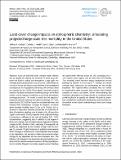Land cover change impacts on atmospheric chemistry: simulating projected large-scale tree mortality in the United States
Author(s)
Geddes, Jeffrey A.; Martin, Randall V.; Heald, Colette L.; Silva, Sam James
Downloadacp-16-2323-2016.pdf (3.675Mb)
PUBLISHER_CC
Publisher with Creative Commons License
Creative Commons Attribution
Terms of use
Metadata
Show full item recordAbstract
Land use and land cover changes impact climate and air quality by altering the exchange of trace gases between the Earth's surface and atmosphere. Large-scale tree mortality that is projected to occur across the United States as a result of insect and disease may therefore have unexplored consequences for tropospheric chemistry. We develop a land use module for the GEOS-Chem global chemical transport model to facilitate simulations involving changes to the land surface, and to improve consistency across land–atmosphere exchange processes. The model is used to test the impact of projected national-scale tree mortality risk through 2027 estimated by the 2012 USDA Forest Service National Insect and Disease Risk Assessment. Changes in biogenic emissions alone decrease monthly mean O₃ by up to 0.4 ppb, but reductions in deposition velocity compensate or exceed the effects of emissions yielding a net increase in O₃ of more than 1 ppb in some areas. The O₃ response to the projected change in emissions is affected by the ratio of baseline NO[subscript x]: VOC concentrations, suggesting that in addition to the degree of land cover change, tree mortality impacts depend on whether a region is NO[subscript x]-limited or NO[subscript x]-saturated. Consequently, air quality (as diagnosed by the number of days that 8 h average O₃ exceeds 70 ppb) improves in polluted environments where changes in emissions are more important than changes to dry deposition, but worsens in clean environments where changes to dry deposition are the more important term. The influence of changes in dry deposition demonstrated here underscores the need to evaluate treatments of this physical process in models. Biogenic secondary organic aerosol loadings are significantly affected across the US, decreasing by 5–10 % across many regions, and by more than 25 % locally. Tree mortality could therefore impact background aerosol loadings by between 0.5 and 2 µg m⁻³. Changes to reactive nitrogen oxide abundance and partitioning are also locally important. The regional effects simulated here are similar in magnitude to other scenarios that consider future biofuel cropping or natural succession, further demonstrating that biosphere–atmosphere exchange should be considered when predicting future air quality and climate. We point to important uncertainties and further development that should be addressed for a more robust understanding of land cover change feedbacks.
Date issued
2016-02Department
Massachusetts Institute of Technology. Department of Civil and Environmental EngineeringJournal
Atmospheric Chemistry and Physics
Publisher
Copernicus Publications
Citation
Geddes, Jeffrey A. et al. “Land Cover Change Impacts on Atmospheric Chemistry: Simulating Projected Large-Scale Tree Mortality in the United States.” Atmospheric Chemistry and Physics 16, 4 (February 2016): 2323–2340 © 2016 Author(s)
Version: Final published version
ISSN
1680-7324